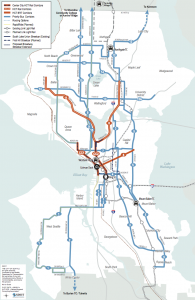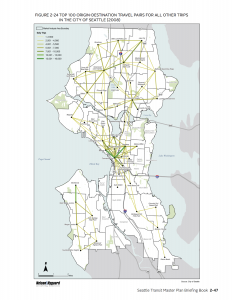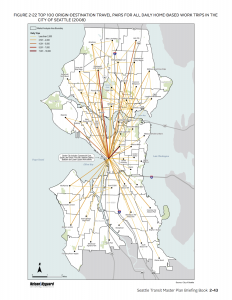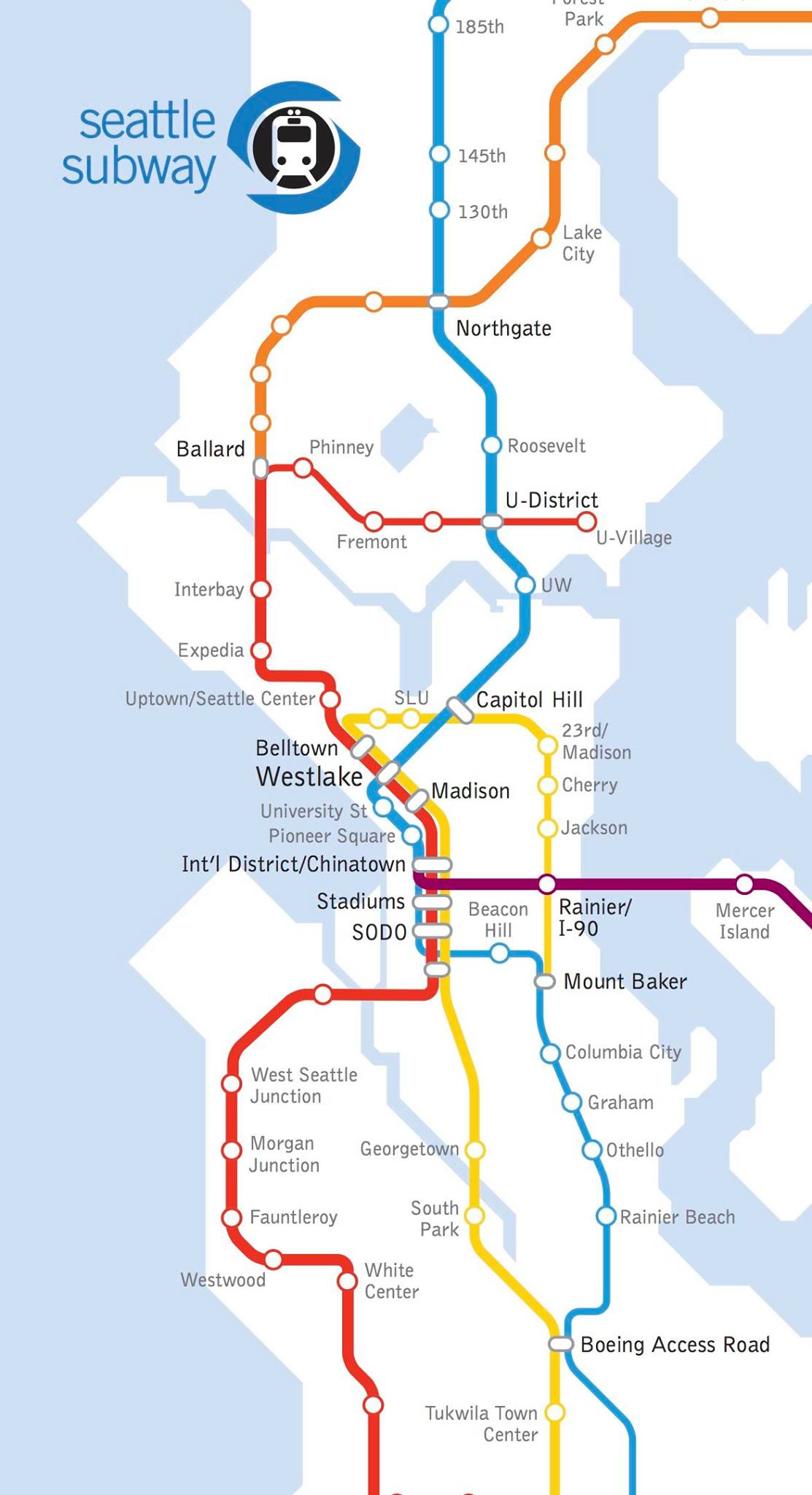As Seattle’s economy continues to grow rapidly and as congestion continues to increase, the upcoming ballot measure Sound Transit 3 (ST3) enables us to provide the infrastructure most necessary to support this growth. It’s a crucial shot in the arm for a region that has been long starved of transportation investments. Therefore it’s important to get it right.
Efficient mass transit is the backbone that supports a healthy urban environment. Dense cities attract people because they enable them to increase the number of people they can learn from to improve their economic and social well-being. As noted in a prior article, an MIT Media Lab paper shows how a doubling of population leads to more than a doubling of economic productivity, known as superlinear scaling. All of this is only possible when there is efficient movement of people and in a dense area this is only possible with dense transportation. But moreover, high levels of interaction are also facilitated by a public realm that supports walking and interaction between people. This means streets need to prioritize walking, sitting and other activities over inefficient car-oriented transportation uses.
To make all of this possible, the fundamental goal urbanists should have with ST3 is provide the most people with the best transit possible.
- The more people benefit directly from the ballot measure, the more people are likely to vote for it.
- The more people experience good transit as a result of the implementation of the measure, the higher the confidence in Sound Transit will become over time and the higher likelihood future measures will pass and we will continue to build a successful rapid transit network.
Transportation Corridors
Transportation demand in Seattle can be divided into three fundamental categories:
- Regional: long-distance connections between King County and the surrounding counties – and specifically connections to Everett and Tacoma
- City: fast and frequent connections between neighborhoods – Seattle’s Transit Master Plan (TMP) has identified the following corridors:

- West Seattle – Downtown via Fauntleroy/California
- Burien TC – Downtown via Delridge
- Othello – U-District via Beacon Ave and Broadway
- Mount Baker – Downtown via Rainier Ave
- Rainier Valley – U-District via Rainier Ave and 23rd Ave
- Central Area-First Hill-Downtown via Madison
- Queen Anne/Magnolia – South Lake Union – Capitol Hill via Denny
- Ballard – Fremont – South Lake Union– Denny Triangle – Downtown
- Aurora Village to Downtown via SR 99
- Northgate – Ballard – Downtown
- Roosevelt – U District – Eastlake – South Lake Union – Downtown
- Lake City – Northgate – U District
- Ballard – U District – Laurelhurst via Market St and 45th St
- Crown Hill – Greenlake – U District
- Phinney Ridge – Greenwood – Broadview
- Local: last-mile access to destinations and to/from nodes of longer-distance transit
Tools at our disposal
How can these corridors be served? The options we have vary based on whether they use exclusive right of way, whether they are fully separated from any interaction with road traffic even at intersections and of course, depending on the type of vehicle used which mainly affects the achievable capacity of a line. All of these factors affect the cost of lines and it’s important to understand the trade-offs as Sound Transit is asking exactly for feedback on which type to use for future lines:
- Grade-separated rail line:
- Form: has no interaction with road traffic – is either elevated, underground or runs on the ground (at grade) in an area inaccessible to traffic or pedestrians (e.g. highway median)
- Reliability: by eliminating potential conflicts with traffic it is typical for 96%+ of trips to be on time
- Capacity: this is the highest capacity option as it allows running vehicles at very high frequency (for Link as much as every 90 seconds) and the vehicles can be very long without concern for how they interact with city blocks (for Link that is 380 ft, limited by station length). This enables our current Link line to carry a theoretical maximum of 32,000 people per hour per direction (pphpd) with some station facility upgrades.
- Cost: From $200m/mile for elevated lines to $400m/mile for tunneled lines
- In street exclusive lane rail line:
- Form: line runs at grade in the street similar to a streetcar but has its own lanes or uses transit-only lanes. The section of Link on MLK Way is a good example of this.
- Reliability: despite having dedicated lanes, such lines still interact with traffic at intersections. This leads to a small number of conflicts on a regular basis which in turn lead to system delays when they occur. As an example, Portland’s MAX light rail system which has significant in-street sections had an on-time reliability of 82% in May 2014, while Link has been hovering around 91% for the last two quarters.
- Capacity: as trains cannot be longer than city blocks (around 200 ft in Seattle) and cannot be reliably run at very high frequencies capacity of such lines can be much lower than grade-separated lines. E.g. a 190 ft train every 2.5 minutes would yield 9,600 people per hour per direction, less than 1/3 that of a grade-separated line.
- Cost: From $50m/mile to $150m/mile
- In street exclusive lane bus line:
- Form: Conventional buses running in dedicated lanes in the street, often in the center to minimize conflicts with turning vehicles.
- Reliability: comparable to that of the in street exclusive lane rail line
- Capacity: is significantly lower: with articulated buses every 2.5 minutes one can only carry 2,760 people per hour per direction assuming total crush-load of 115 people per bus.
- That is less than one third of the capacity of the exclusive lane rail line and less than one tenth the capacity of the grade separated line.
- And this is the most important part. People often assume that buses can deliver the same service as rail if they have exclusive lanes and can be run at comparable frequency, speed and reliability rates. The problem is that due to the low per vehicle and total capacity, as such systems start attracting higher ridership they quickly reach the point where demand at a given time is higher than the available service, or in other words lead to crush-loaded buses. And a crush loaded bus represents a transit experience that is so degraded that it starts detracting some of the existing ridership. It’s basically a system that scales very poorly.
- Cost: $20m – $40m/mile
Implementation
So what’s on the table? The Seattle corridors have been studied by both the City and Sound Transit. The following table lays out what options have been suggested for each corridor and by whom, sorted by 2030 prediction for potential bus ridership as a unifying baseline:
| Corridor | 2030 bus ridership projection (+gain) | Project proposals |
|---|---|---|
| Rainier Valley – U-District via Rainier Ave and 23rd Ave | 17,200 (+3,600) | Partially covered by Central and East Link |
| Ballard - Interbay - Uptown - Belltown - Downtown(Northgate – Ballard – Downtown) | 16,900 (+4,400) | Sound Transit 3: C-01a: mostly exclusive lane rail; movable bridge across Ship Canal C-01b: elevated rail through Interbay, tunnel through Uptown and Downtown, movable bridge C-01c: elevated rail with movable bridge or tunnel Ship Canal crossing |
| Ballard - Fremont - South Lake Union- Denny Triangle - Downtown | 16,000 (+6,400) | Sound Transit 3: C-01d: Exclusive lane rail, movable bridge City of Seattle: TMP Corridor 8: Exclusive lane rail * |
| Roosevelt - U District - Eastlake - South Lake Union - Downtown | 15,000 (+4,300) | City of Seattle: TMP Corridor 11: Exclusive lane rail * |
| Queen Anne/Magnolia – South Lake Union – Capitol Hill via Denny | 14,700 (+4,200) | |
| West Seattle Alaska Junction - North Delridge - downtown and West Seattle Delridge | 14,500 (+4,200) | Sound Transit 3: C-03a: elevated rail over existing or new bridge C-03b: at-grade rail over existing or new bridge (may not have exclusive lanes) |
| Central Area-First Hill-Downtown via Madison | 12,500 (+4,500) | City of Seattle: TMP Corridor 6: Exclusive lane bus |
| Aurora Village to Downtown via SR 99 | 12,400 (+3,900) | |
| Othello – U-District via Beacon Ave and Broadway | 11,100 (+3,900) | |
| Mount Baker – Downtown via Rainier Ave | 11,000 (+5,700) | |
| Phinney Ridge – Greenwood – Broadview | 9,600 (+2,300) | |
| Ballard – U District - Laurelhurst via Market St and 45th St | 8,900 (+1,400) | Sound Transit 3: C-02: all-tunnel rail |
| Burien TC - Downtown via Delridge | 7,900 (+2,300) | Sound Transit 3: C-03c: at-grade and elevated rail with new low bridge |
| Crown Hill – Greenlake – U District | 7,400 (+1,100) | |
| Lake City – Northgate – U District | 4,600 (+1,300) | |
| Downtown connection between north and south lines | Sound Transit 3: C-04: tunnel C-05: at-grade C-06: capacity improvements to existing DSTT C-07: increasing train frequency ID-Northgate |
City *: The 2012 TMP suggests using a mixture of exclusive lanes and mixed-traffic operation, but since then the city has taken measures to move existing mixed-traffic projects to exclusive lanes and it is likely to follow suit for those as well.
Also take a look at the following maps from the TMP which show how people move around Seattle – with origin-destination pairs for work and non-work trips. This can help inform your decisions.


What can you do as an urbanist?
Fill-out the official Sound Transit 3 survey and:
- Support fully grade separated options to Ballard (C-01b, C-01c), West Seattle (C-03a) and through downtown (C-04). These are the highest ridership lines connecting major growth centers and the transit we build to them has to be scalable for future needs. The ridership gain and decongestion effects from the improved reliability of grade-separated lines will also be the highest here.
- Support east-west corridors like the Ballard – Wallingford- U District via 45th (C-02) and Queen Anne – SLU – Capitol Hill (not proposed, you can suggest it). Building a network that requires going through downtown to go from one neighborhood to the other does not reflect actual movement patterns (as shown above) and will hinder achieving urbanist goals in areas of inadequate transit service.
- The original Sound Transit Ballard to downtown Seattle Transit Expansion Study included a Corridor D in its Phase 2 which covered Ballard – Fremont – Queen Anne – Belltown – Downtown. According to the map above, not only does that corridor cover 2 of the major routes for work trips, it also covers non-work trips in the Ballard-Fremont and Queen Anne-Belltown areas and non-work trips represent 83% of all trips. Suggest this corridor be kept for studying in your comments.
- Note that Corridor C-01d, Ballard – Fremont – SLU – Downtown is something the City of Seattle will pursue if ST doesn’t address it, so it’s worth focusing the ST effort on the other corridors and leaving this one to the city. If you are feeling particularly proactive you can e-mail the Seattle City Council asking that it be studied.
Moving forward
It’s important to not be penny-wise, pound-foolish and prevent the loss of long-term benefits in the name short-term savings. Seattle will be able to sustain much higher economic growth if it builds quality lines even if it means lower mileage. Rail projects are inherently long-term focused and short term thinking here would be inexcusable. The decisions made on a potential Sound Transit 3 ballot measure has the power to determine whether our region will continue to grow as a desirable urban area or will change to deliver a lower quality of life due to an inadequate transportation backbone.

Anton Babadjanov
Anton has been living in the Pacific Northwest since 2005 and in Seattle since 2011. While building technology products during the day, his passion for urban planning and transportation is no less and stems from a childhood of growing up in the urban core of a small European city.

